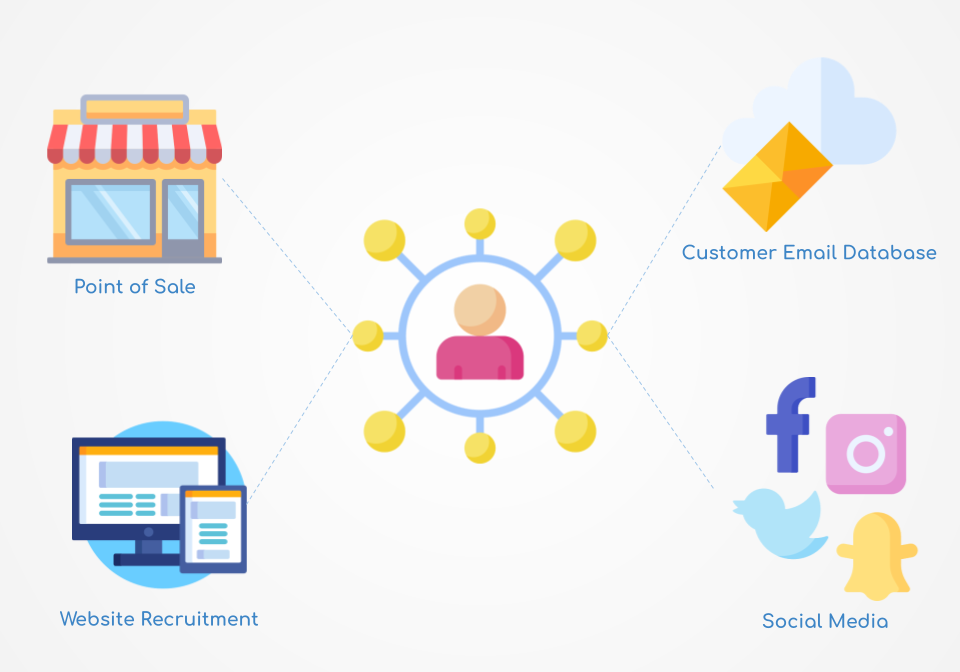In this Article
If you have done any user research or UX testing, you will know firsthand how expensive recruitment costs can be. A large chunk of the UX budget is often taken up by the cost of respondent recruitment alone. Considering that, the thought of building your own research panel doesn’t seem like such a bad idea at all.
Build Your Own Research Panel
Building your own research panel can be done entirely on your own or with the help of recruitment agencies, saving you time and effort because building a research panel on your own is not an easy task.
There is a significant advantage to building a research panel for Asia. In Southeast Asia for example, in countries like Thailand, Indonesia, Vietnam, the Philippines, Malaysia and Singapore, the general population has a mobile-first culture and are very comfortable with technology. In addition, bilingualism is fairly common in Southeast Asia.
Building your own research will take a bit of time and effort now but the long term benefits far surpasses the necessary initial investment. You will see, there are many benefits of building your own research panel.
Benefits of Having Your Own Research Panel
When you have your own research panel, you have a group of respondents that are ready and willing to participate. This allows the benefit of conducting more research at a faster pace without the hassle of starting the entire recruitment process at the start of each study.
Being able to conduct research with a shorter lead time provides the ability to test faster and more frequently, which in turn improves the entire design cycle.
Furthermore, your panel members have already opted in and are invested in your research which motivates them to respond well and respond fast as well, resulting in increased response rates. When respondents are invested in your company, they are more open and willing to participate in research because they want to help.
Not to mention, by going back to the same group of respondents time after time, it opens up a great opportunity in building rich respondent profiles that will help match the right people to the right study. The benefit of building deeper insights in this manner is unique to having your own research panel.
Aside from the benefits of being able to do more research at a faster pace, obtaining increased response rates, as well as the opportunity to build deeper insights, it’s all done at a reduced cost of research. By managing your own research panel (or getting help from an agency to manage the panel), you save more time and you will not need to restart recruitment for each round of study.
How to Build & Maintain Your Own Research Panel
Now that we’ve established the numerous benefits of having your own research panel, let’s look at practical steps on how to actually build one.
Building the panel is a simple three-step process, the first step is to decide how many respondents you need to recruit, the second step is to recruit, and the third step is to maintain.
1. Determine the Panel Size
This first step will help you figure out how many people you need to recruit. To do this, we’ll need to know your ideal sample size, the response rate and how many research studies you have planned.
There’s a simple formula we can use to calculate how many respondents to recruit:
Sample size per survey/response rate x studies per month
For example, if you need 300 as the sample size per survey with the response rate of 30% and you’re aiming to have 3 studies per month, you’ll need 3,000 respondents.
300/30% x 3 = 3,000 respondents
Do take note to factor in geographic quotas, this helps to ensure that there is a good sample size covering different regions and demographic profiles, it also helps in obtaining a strong mix of age and gender.
Ensure that you have all the necessary requirements before going into recruitment and aim to recruit 10-20% more to cover any instances where people choose not to opt-in or to blanket the target response rate just in case.
2. Recruit
With the recruitment criteria and requirements in hand, a target number of respondents in mind, it’s time to recruit.
There are many places you can look at to recruit respondents, start by looking at the range of channels you and your company are already using:
- Customer Email Database
- Point of Sale
- Website Recruitment
- Social Media

You could consider exploring external channels too, this is handy if you want to gather responses from prospects or competitor’s customers. If you need more people, advertising is another way to recruit respondents. As well as lead generation networks to use affiliate networks to reach a wider range of people.
The best starting point is always to look within, your customers are people who have already used or purchased your products/services and maybe even recommended it to friends and family. Reach out to people who have tried your products/services but have gone with your competitor instead, these people can provide a vast amount of insightful information. Consider looking at people who have requested information from you in the past – those who have made an enquiry.
It’s important to point out that though it may be tempting to only include customers as potential recruits, it poses a risk because customers already have existing strong feelings towards your company.
Customers with pre-determined opinions, whether good or bad, are important to consider for useful feedback but be careful not to include only customers in your panel because there is too much bias involved. Have a strong mixture of people from various sources.
Enthusiastic customers make for great brand ambassadors but when it comes to research, they will shape their feedback according to their feelings towards your brand. Though they may think it’s helpful, it’s still biased.
If you don’t have any customers yet, it’s a great opportunity to open up to people and ask them to get involved in crafting your product or service offering. Since you’re already in the process of understanding their pain points to drive your product development, why not get them on board and include them in your research panel?
Finding respondents is the hardest part and it will take time, don’t expect to have it all sorted in a few weeks time. Take the time and effort to culminate a mixture of people to make up a strong research panel.
3. Maintain Your Panel
The challenge here is keeping the panellists engaged and ensuring that all the respondents get an equal opportunity to participate in the user research. After going through so much effort to build your panel, it would be a great shame to lose them due to lack of maintenance.
Maintaining your panel is crucial in keeping your respondents continually engaged and invested, this part is tricky and involves quite a lot of continued effort on a frequent basis.
It’s also important to avoid creating “experienced testers”, experienced testers are created through over-testing as they become an expert from the frequency of the studies. Once they have been over-tested, they won’t accurately represent your target audience.
For experienced testers, their skilled behaviour is often an automated behaviour in which they don’t even realise. Experienced testers can become design critics as opposed to staying in the user role and engaging with the actual study.
4. Engage Help From UX Specialists
This is a bonus step which is a great alternative to building and maintaining the research panel yourself.
Instead of doing all the legwork, consider engaging a company that specialises in UX, user research or UX testing that will create and manage your panel for you. Doing so is still more affordable than frequently using recruitment agencies and it frees you and your team up to focus on managing the finer aspects of user research.
Furthermore, UX research companies like Netizen Experience have vast experiences and skills when it comes to building and maintaining respondent research panels. By engaging their services, their existing knowledge and expertise will go a long way in cultivating and strongly maintaining your research panel.

Best Practices
- Be authentic in your communication.
Read the message you’re sending out, would you be likely to respond to it? Convey your interest to respondents for their valued opinion, and be real in your communication, don’t sound like a robot.
- Create short & easy surveys.
The easier the survey, the more likely the respondent will complete it. Don’t ask redundant questions for their name and email address when you already have it.
- Create a separate brand for your panel.
A separate brand stands out and it helps your respondents feel exclusive when they open your emails. It should stand out from the company promotional emails, and you want your respondents to feel important and encourage them to open the survey emails or invitations to research sessions. The brand for your panel should have its own look and feel but still be compatible with your company brand for a harmonious look.
- Don’t email customers that have opted out of email communication.
If you want to recruit existing customers, be careful not to email any customers that have decided to opt-out of email communications from your company. Doing so will largely have an adverse effect and you may risk losing that customer entirely.
- Have an internal point person
This person will serve as the name and face for the panel respondents, they will manage the panel and communicate with them, this gives a much more personal and authentic feeling instead of automated robotic communications.
Instead of having various different people communicating with your respondents, appoint or create a persona to be the face for all communication. It could even be a general email such as panel@company.com
- Communicate consistently but not too much!
Set a limit and stick to it. If you tell respondents that you will send surveys or invitations to research sessions twice a month, stick to what you tell them. Don’t overdo it and ask too much from them.
If you don’t send out enough surveys and invitations, less than twice a month as promised, your panels will start to lose interested and won’t take it seriously either. Some planning is needed here to hit the right frequency of communications.
- Address complaints quickly
If any respondent has negative feedback or wants to address an issue, ensure that it’s being followed up in a quick manner. Respondents have agreed to be in your panel to offer their opinions and they need to feel like their voice is being heard or you risk the possibility of them dropping out.
- Reward & incentivise your respondents
Incentives and rewards are not only important in attracting respondents but they are key in keeping up response rates for when you launch surveys or research sessions.
Do take care to keep your incentives relevant, cash is still king, monetary incentives perform much better than gifts. If cash is an issue, consider gift vouchers that is relevant to your respondents.
- Update your respondents
Respondents will want to know that their time and effort was not wasted, keep your respondents engaged by keeping them updated with the results and how their responses and contribution has helped. This encourages your respondents in knowing that their opinions really matter and they will feel more invested.
Happy building and maintaining your own research panel!
If you are looking to conduct better respondent recruitment, here are the best practices to research participant recruitment in South East Asia.
Respondent Recruitment Services


Key Highlights
- Identify and recruit respondents who precisely match the desired demographic, psychographic, or behavioral criteria
- Usage of various channels, such as online platforms, social media, and community networks, to reach a wide range of potential respondents
- Streamlined screening and qualification process that efficiently filters out ineligible respondents
- Tailored respondent recruitment solutions to meet specific research objectives
- Quick turnaround times, enabling businesses to gather the required number of participants within their project timelines
- Commitment to quality by assuring clients of a rigorous quality assurance process with dedicated and experience project managers

